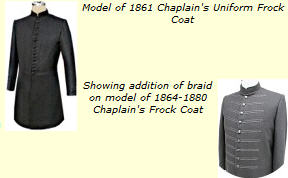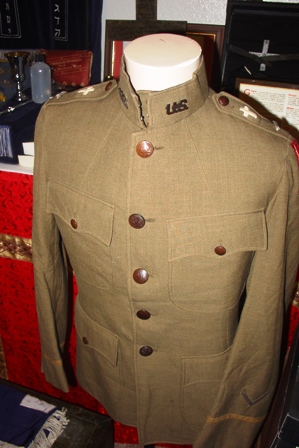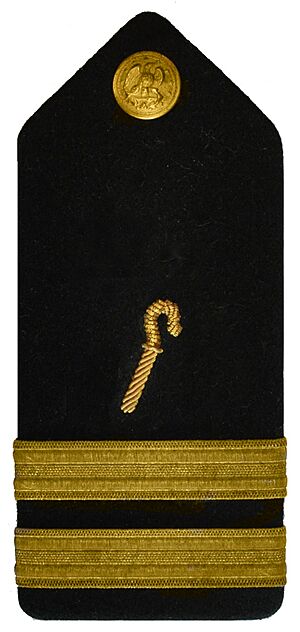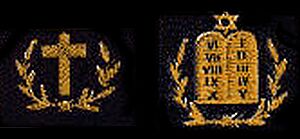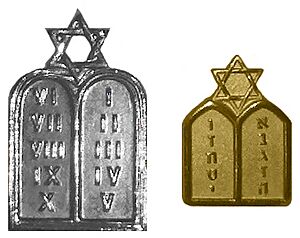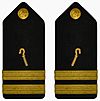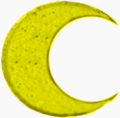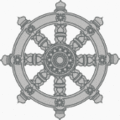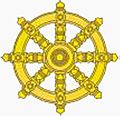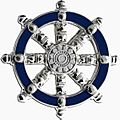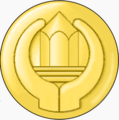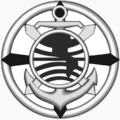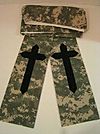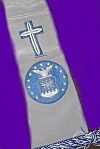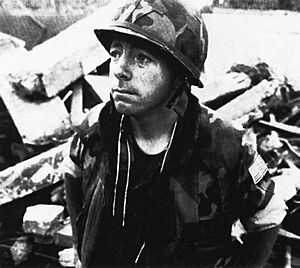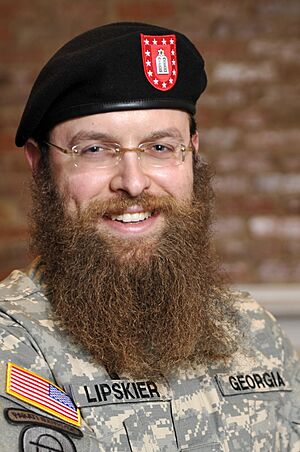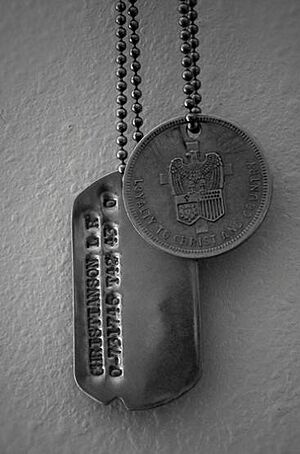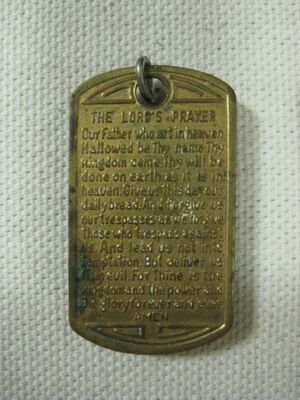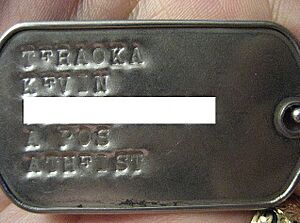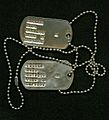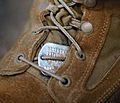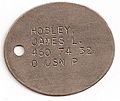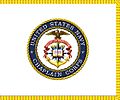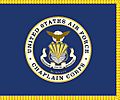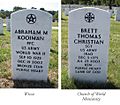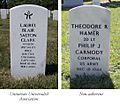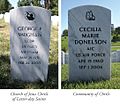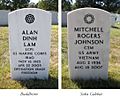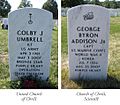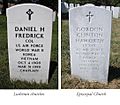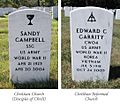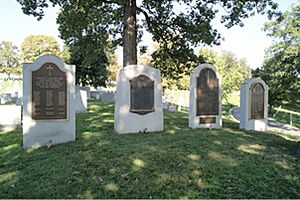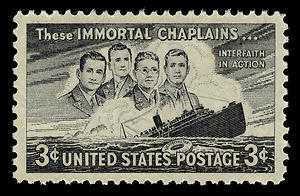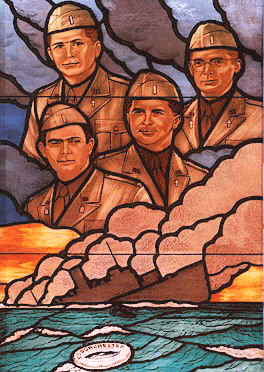Religious symbolism in the United States military facts for kids

Religious symbols are important in the United States military. They appear on uniforms, flags, and chapels. They are also part of military ceremonies and rituals. You can even see them on headstones in national cemeteries. Military ID tags, called "dog tags," also show religious symbols.
Sometimes, symbols are chosen or left out for religious reasons. Colors with special religious meaning are also used. The military also has rules for wearing religious clothing or keeping certain hairstyles. This is called "religious accommodation." Chaplains, who are religious leaders in the military, are often seen as symbols of faith themselves. They help military personnel with their beliefs and values.
Religious Symbols for Chaplains
Chaplains are religious leaders who serve in the military. They wear special symbols to show their role and faith. These symbols have changed over time for different military branches.
Army Chaplain Symbols

The Continental Congress started the military chaplaincy on July 29, 1775. But chaplains did not wear special symbols until 1880. Before that, in 1835, Army rules said chaplains should wear a black coat. This black color was a symbol of their religious role.
The Latin cross has been the main symbol for most U.S. military chaplains for a long time. But the very first official chaplain symbol in 1880 was the "shepherd's crook" (a staff). It was a silver symbol on black velvet shoulder straps. This symbol was used until 1888. Then, the plain Latin cross became the official symbol in 1898. Today, the shepherd's crook is still part of the Army Chaplain Corps symbol. This honors its history.
Jewish chaplains first served during the American Civil War. But the question of their symbols came up during World War I. A congressman asked the army if rabbis could wear a different symbol instead of the cross. The army first allowed Jewish chaplains to wear no symbol. But this caused problems on the battlefield. So, the army looked for a new symbol.
They decided on a separate symbol for Jewish chaplains. This symbol showed the two tablets of the Ten Commandments. It used Roman numerals for the commandments. A small six-pointed Jewish star was on top of the tablets. This symbol was used until 1981.
In 1981, the Navy changed its Jewish chaplain symbol. It replaced the Roman numerals with the first ten letters of the Hebrew alphabet. The Army and Air Force soon followed this change. For other faith groups, symbols for chaplains are decided together by all military branches.
The Continental Navy started on October 13, 1775. Its rules said that ships should have religious services. This showed the need for navy chaplains from the start. But it took a long time to decide on their uniforms and symbols.
In 1847, navy rules allowed chaplains to wear a blue uniform with no symbol. Later, in 1864, they wore the same uniform as other staff officers. They used a silver cross as their symbol. But these rules changed many times over the years. Sometimes chaplains wore no symbols at all.
It was not until 1905 that the navy had a permanent rule for chaplains' uniforms. They wore naval officer uniforms with black sleeve braid (not gold like other officers). They also wore officer rank symbols and a gold cross. In 1918, the black braid changed to gold, like other officers. The Latin cross remained their symbol.
The Navy took longer to decide on a symbol for Jewish chaplains than the Army. When Rabbi David Goldberg joined the Navy in 1917, he was told to wear the Latin cross. He wore it at first. But after hearing from other rabbis, he asked to wear the Star of David instead. The Navy said no because it looked too much like the five-pointed star worn by generals.
Goldberg then suggested the shepherd's crook as a symbol for all chaplains. Many Christian chaplains did not like this idea. But the Navy allowed Goldberg to wear the shepherd's crook himself. He wore it until the end of World War II. In 1941, the Navy finally allowed Jewish chaplains to wear the tablets and star symbol, just like the Army.
Today, the Navy chaplain with the earliest appointment is called the "Gray Shepherd." This is a nod to the old shepherd's crook symbol.
Marine Corps and Coast Guard Chaplains
Navy chaplains also serve the Marine Corps and Coast Guard. They can wear Marine Corps or Coast Guard uniforms when assigned to those units. But their chaplain symbols are always Navy symbols.
Merchant Marine Chaplains
The United States Merchant Marine is a civilian group that helps the Navy. During wartime, its members are considered military. Uniforms were introduced in 1919. They looked like Navy uniforms but had differences. Chaplain symbols with wreaths were created around 1943. Today, Navy chaplains serving with the Merchant Marine wear standard Navy uniforms and symbols.
Air Force Chaplain Symbols
On July 28, 1942, Chaplain Charles Carpenter became the first air chaplain for the Army Air Force. When the United States Air Force became a separate service in 1947, Army chaplains still supported them. But in 1949, the Air Force decided to have its own chaplains.
Air Force chaplains wore Air Force uniforms. They used the same Jewish and Christian chaplain symbols as the Army. In 1981, when the Navy changed the Jewish chaplain symbol to Hebrew letters, the Army and Air Force also made this change. Since then, symbols for other faith groups have been approved jointly by all military branches.
The Air Force calls these symbols "occupational badges." They have different rules for how they are worn. The Civil Air Patrol chaplain program also follows these same rules for faith group symbols.
Chaplain Symbols by Faith Group
Christian Chaplain Symbols
The Latin cross has been the symbol for all Christian chaplains in the U.S. military. This is true regardless of their specific Christian group. Some other countries use different crosses for different Christian groups. The U.S. Department of Veterans Affairs also uses different crosses on gravestones in veterans' cemeteries.
Some Christian groups, like The Church of Jesus Christ of Latter-day Saints, do not usually use the cross symbol. But they accept it as the uniform symbol for Christian military chaplains. They see it as a way to show they are Christian chaplains. The Unitarian Universalist Church also does not typically use the cross. But their military chaplains wear it as they are considered Protestants.
Messianic Jewish Question
In 2008, a clergyman named Michael Hiles, who identified as a Messianic Jew, wanted to be a Navy chaplain. He asked to wear the Jewish chaplain symbol. Messianic Jews accept Christian beliefs about Jesus. The Navy decided that Hiles had to wear the Christian cross symbol. He chose to leave the training instead.
Jewish Chaplain Symbols
The Jewish chaplain symbol shows two tablets of the Ten Commandments. It has ten Roman numerals and a six-pointed Star of David above them. This symbol was adopted for Jewish Army chaplains in 1917. It was adopted for Navy chaplains in 1941.
Before this symbol, only two Jewish Navy chaplains wore the Shepherd's Crook symbol. Chaplain David Goldberg wore the cross first. Then he got permission to wear the Shepherd's Crook.
In 1980, Navy Jewish chaplains suggested changing the Roman numerals to Hebrew letters. Some Jewish leaders worried that Hebrew writing might make the symbol too "holy." But a panel of Jewish chaplains agreed to the change. The Navy approved it in December 1980. The Army and Air Force quickly followed. The new symbol with Hebrew letters was allowed from 1981. Chaplains had until January 1, 1983, to update their uniforms.
- Jewish chaplain insignia
Muslim Chaplain Symbols
On December 14, 1992, the Army Chief of Chaplains asked for a symbol for future Muslim chaplains. The design, a crescent moon, was finished on January 8, 1993.
Buddhist Chaplain Symbols
In 1990, the Army decided to create a symbol for future Buddhist chaplains. The design was finished in August 1990. It shows the dharmacakra, also called the "wheel of dharma." This is an eight-spoked wheel that represents religious practices.
Hindu Chaplain Symbols (in planning)
As of 2011, a Hindu organization was approved to endorse Hindu chaplains for the U.S. military. Military officials and Hindu community members worked to consider possible symbols. One suggestion was the "om" symbol, which means "truth and peace."
The first Hindu chaplain in the U.S. military was Army Captain Pratima Dharm. She is also the first female of Indian descent to be a U.S. Army chaplain. She had worn the Christian cross symbol before. But now she is endorsed by a Hindu organization.
Religious Program Specialists
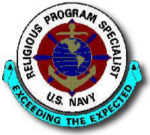
Enlisted personnel who help chaplains do not wear specific faith symbols. But they have military symbols that show their role. These symbols often include broader ideas of faith and care.
The Army Chaplain Assistant Badge was approved in 1984. It shows cupped hands, meaning support for the chapel. A chapel door symbolizes a welcome to all worshippers.
The Navy's Religious Program Specialist (RP) badge has a compass rose, a globe, and an anchor. The compass means religion can guide life. The globe shows that RPs work worldwide. The anchor represents Navy history.
The Air Force has three levels of Chaplain Assistant Badges. These depend on training and qualifications. The badge was created in 1994. Its design is based on the theme "Live by faith." It symbolizes supporting the religious needs of the Air Force community.
- Chaplain's Assistant Badges
Religious Clothing and Grooming
Chaplains' Religious Clothing
Military rules allow chaplains to wear religious clothing or items with their uniform. This is for worship services and religious ceremonies. Some religious clothing is given by the military. It might have military or chaplain symbols.
In the 1960s, the Army Chief of Chaplains had a lapel pin made for chaplains to wear with civilian clothes. It showed the Army Chaplain Corps seal. But government money was not allowed for this, so production stopped.
Faith Group Clothing
Military-Issued Clothing
- Military issued scarves/stoles
All Military Personnel: Clothing and Grooming
Military rules allow all personnel to wear religious clothing under their uniform. It must not be visible or obvious. If it is visible, it must be "neat and conservative." This means it should be tidy and not too flashy.
Each military branch has rules for religious head coverings. They often need to blend with uniform colors. For example, the Air Force requires dark blue or black head coverings. The Navy and Coast Guard require black or hair-colored ones. The Army requires subdued colors like black, brown, or dark blue. These head coverings should not have any writing, symbols, or pictures.
Religious jewelry is also allowed. It must follow the same "neat, conservative, and discreet" rules as other jewelry. Tattoos that promote religious discrimination are not allowed.
Beards in the Military
All branches of the U.S. military currently do not allow beards. Some mustaches are allowed if they are neatly trimmed. The ban on beards started around World War I. One reason given was the need for gas masks to fit properly. Another reason was hygiene, as many recruits from rural areas joined.
Historically, beards were common in the U.S. military. Many generals during the Civil War had beards. But by World War II, beards were completely banned. The Navy briefly allowed beards from 1970 to 1984.
Religious laws and traditions often involve hair and beards. For example, Sikh men do not cut their hair or beards. Some groups in Judaism and Islam also believe shaving is not allowed. Requests for religious beard waivers are decided at the highest levels of each military branch. The Army approved new waivers in 2009 for the first time in over twenty years. But these waivers are temporary and for specific assignments.
Beards have also been allowed for non-religious reasons. This includes medical reasons for skin conditions. Some Special Forces members were allowed to grow beards in places like Afghanistan. This was to blend in with locals and show respect. However, this policy changed in 2010.
Some military leaders worry that beards interfere with gas masks. But others argue that applying petroleum jelly can help seal the mask. For example, Jewish Chaplain Jacob Goldstein, who has a beard waiver, showed he could put on his mask quickly and safely.
Some military officials say religious beard waivers can be considered case-by-case. But critics say this policy is unfair. It would require someone to shave to enlist, then ask for a waiver to grow their beard back. Some believe the real reason for the ban is that beards are seen as "sloppy." Army rules state that a neat appearance is key to discipline.
Kippot/Skullcaps
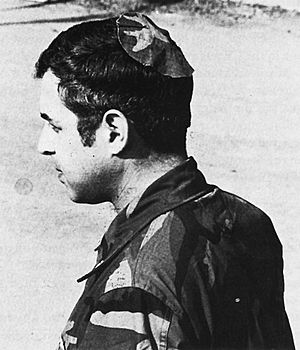
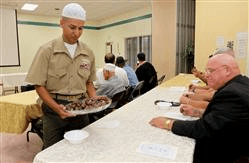
The kippah (skullcap) worn by some Jewish personnel is an example of allowed religious clothing. It must pass the "neat and conservative" test. The modern rule allowing the kippah started after a 1986 Supreme Court case. An Orthodox rabbi in the Air Force was told to remove his kippah. The court said the military could ban it.
But then, Congress passed a "Religious Apparel Amendment." This happened after a story about two Navy chaplains during the 1983 Beirut barracks bombing. Catholic Chaplain George Pucciarelli used a piece of his uniform to replace Jewish Chaplain Arnold Resnicoff's bloodied kippah. This story showed interfaith cooperation. President Ronald Reagan spoke about it, explaining that Americans can be proud of their religions and still work together.
The story of this "camouflage kippah" became a symbol of respect between faiths. The rules for head coverings apply to all faiths. They must be neat and conservative.
Beards and Turbans: Sikhs
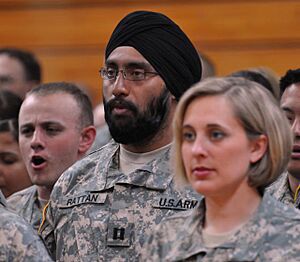
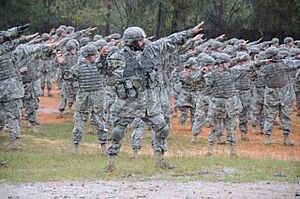
Sikh turban and beard rules have a unique history. Sikh men served in the military with waivers for their beards and long hair (covered by turbans) since 1948. But in 1984, the Army stopped these religious accommodation policies.
However, in March 2010, Army Captain Tejdeep Singh Rattan became the first new Sikh officer in over 25 years allowed to serve with a beard and turban. Other Sikhs have also been granted permission, including Army doctor Captain Kamaljeet Singh Kalsi. In 2011, Army Specialist Simranpreet Lamba became the first enlisted Sikh man to get a waiver for his beard and turban.
The Army reviews each religious accommodation request for grooming individually. They are not "blanket accommodations."
Beards: Muslims
As of June 2011, some Muslim soldiers have also been allowed to keep beards for religious reasons. One is a surgical intern at Walter Reed Medical Center. Many Muslim leaders agree that a beard is part of Islamic dress code.
Beards: Jews
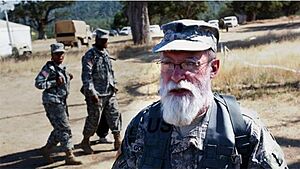
Since 2009, Orthodox rabbi Menachem Stern has asked for permission to wear a beard as a Jewish chaplain. He even filed a lawsuit in 2010. His lawyer argued that chaplains teaching religion should be allowed to have beards.
One waiver for beards has been given to Army Reserve Chaplain (Rabbi) Jacob Goldstein. He has served since 1977, including deployments to places like Afghanistan. He was the only Jewish chaplain in Grenada in 1983. In 2003, he even set up a sukkah (a religious hut) in Saddam Hussein's palace in Iraq.
In December 2011, Rabbi Stern won his lawsuit against the Army. He was allowed to serve without shaving his beard. Stern became an Army chaplain in 2013.
New Military Policies (January 2014)
As of January 22, 2014, new military rules were put in place. For the first time, grooming rules, like wearing beards, were officially part of "religious accommodation." This means there are now clear ways for individuals to request to wear beards for religious reasons.
Military ID Tags

The military ID tag, or "dog tag," is a government-issued item that shows a person's religion. Two tags are worn around the neck. If a person dies, one tag is removed for records, and one stays on the body. The tag helps identify the person and provides medical info. It also shows religious affiliation. This helps chaplains of that faith respond, especially for religious rituals like "last rites." Religious info also helps with burial plans.
People can also wear a small religious symbol, like a cross or Star of David, on their ID chain. This is for personal reasons or to make religious identification easier.
The idea of identification tags started in the Civil War. In 1906, the Army made tags official. In 1916, they required two tags.
During World War II, dog tags could show one of three religions: "P" for Protestant, "C" for Catholic, or "H" for Jewish (from "Hebrew"). Or they could show "NO" or "NONE" for no religious preference. Later, "X" meant any other religion, and "Y" meant no religion or not listing one. In 1953, a veteran tried to get "M" for Muslim added, but it was not successful.
By the Vietnam War, ID tags spelled out religions like PROTESTANT and CATHOLIC. They also started to show specific groups like "METHODIST." Today, military personnel can list any religion or belief system on their ID tags. This includes "Wicca" or "Atheist."
Some military personnel choose not to list their religion on their tags. They might fear that identifying as a certain religion could put them in danger if captured. For example, some Jewish personnel avoided flying over German lines in WWII with tags showing their religion. Some still avoid it today if they fear being captured by extremists.
Symbols on Flags and Pennants
In the Navy, a "worship pennant" is flown when a chaplain leads a service on a ship. This pennant shows the chaplain's faith symbol. It is flown above the United States flag. This is the only time another flag can be flown above the U.S. flag.
The first worship pennant showed a cross. But in 1975, the Secretary of the Navy approved a "Jewish worship pennant." It showed the Jewish Chaplain symbol. These pennants can also be flown ashore during services.
The Marine Corps Flag Manual allows Navy worship pennants. They are used to show the time and place of religious services. They also mark the chaplain's office in the field.
The Army uses official Chapel flags for military chapels. Smaller Chaplain flags mark where services are held in the field. These flags are dark blue with the appropriate chaplain symbol in white. They are available for Christian, Jewish, Muslim, and Buddhist use.
The Army also has other flags. The "regimental color" shows the Chaplain Corps emblem on a dark blue background. The "positional color" for the Chief of Chaplains has the emblem on a white background. Army general officers' flags usually have white stars on a scarlet background. But Chaplain Corps general officers' flags have "ecclesiastical purple" backgrounds.
The Navy has a flag with its Chaplain Corps emblem. The Air Force has a Chaplain Corps flag, also called a "Religious Flag." It has the Chaplain Corps emblem on a blue background. This flag can be displayed at military events and ceremonies. It is always displayed in Air Force chapels.
Chaplain Corps Flags
Army (Regimental color)
Chief of Chaplains Flags
Positional Colors (Army)
Chapel and Chaplain Flags (Army)
Chapel and Chaplain flags look the same but are different sizes. The Chapel flag is larger and has white fringe. The Chaplain's flag is smaller. Both show the chaplain's faith symbol. Chapel flags are only flown in military chapels. Chaplain's flags are used to mark services or the chaplain's office in the field.
-
Army Jewish and Christian Chapel Flags. They are shown in front of a temporary chapel after the September 11 attacks.
Chaplain School Flags
The Army Chaplain School flag is an official flag. The Navy Chaplaincy School and Center flag is made locally and is not official. The Air Force does not seem to use a Chaplain School flag.
Symbols and Military Chapels
Chapel Construction and Usage

Since 1940, military chapels have been built without permanent religious symbols. This applies to both the outside and inside. This policy was made to respect all religious beliefs. Before 1940, military chapels always had a cross.
Today, all new chapels follow this rule. They do not have permanent religious symbols. Temporary symbols can be used only during scheduled religious services. For example, Army rules say that chapels must be "religiously neutral" when not used for services. Portable symbols can be used during worship but must be moved or covered afterward.
Navy rules also state that chapels are "nonsectarian." This means they are for all faith groups. They should not have architectural symbols that belong to only one religion. Air Force rules also say, "Do not use religious symbols" on the exterior. They also say stained glass windows should not contain religious symbols.
Removing Denominational Symbols
Policies vary when it comes to removing permanent religious symbols from older chapels. These decisions can sometimes cause arguments.
For example, in 2008, the Army planned to remove three wooden crosses outside a chapel in Kosovo. They wanted to replace them with a monument showing the Chaplain Corps seal. This was to follow Army rules that exteriors should be free of specific faith symbols. Similarly, a cross was removed from a military chapel in Afghanistan in 2011.
However, in 1998, the Walter Reed National Military Medical Center in Maryland added a crescent moon to its chapel. A cross and Star of David were already there. They chose to add a new symbol rather than remove all of them.
In one case, a cross was removed from a chapel and then put back. This happened at Naval Submarine Base New London in Connecticut. The cross was not part of the original chapel. Its removal caused controversy. But the next commanding officer had it replaced.
Navy policy may be more flexible about existing symbols if a base has more than one chapel. For example, Naval Station Norfolk has separate Catholic, Protestant, Jewish, and Muslim chapels.
The rule about chapels being religiously neutral also applies to Veterans Administration chapels. In 2008, a chaplain resigned after Christian symbols were removed from a hospital chapel. This happened after complaints about religious insensitivity.
-
Chapel at Camp Bondsteel in Kosovo during a Presidential visit. Makeshift crosses later put on the grounds were removed.
-
Chapel at Walter Reed National Military Medical Center (Bethesda, Maryland). A crescent was added to symbols of the cross and Star of David in June 1998.
Erecting and Removing Religious Symbols Apart from Chapels
A different issue involves a cross on a military base. A 13-foot cross was put on a hill at Marine Corps Base Camp Pendleton in California. It was a memorial to Marines killed in Afghanistan. Some argue it should stay as a universal symbol of remembrance. Others say it should be removed because it is a religious symbol.
Vandalism Using Religious Symbols

In 2010, vandals used a religious symbol negatively. They added a wooden cross to a non-Christian worship area at the United States Air Force Academy (USAFA). This area, a "stone circle," is for "Pagans" like Wiccans. This act was seen as an anti-religious statement.
The USAFA Superintendent, Lieutenant General Michael C. Gould, said it was important to support all cadets' religious needs. He said that respect for others' beliefs is a key lesson for cadets. They learn to respect people they lead and serve with, even if beliefs differ. Academy officials took action to show that the "Cadet Chapel Falcon Circle" should be treated with respect.
Lack of Symbols as Symbol
Some say that the lack of permanent symbols in chapels is itself a symbol. It shows how people of different beliefs can get along. Father Dennis Hanley, a Catholic chaplain, said military chapels are a "model for interfaith ecumenical cooperation."
Symbols in National Cemeteries

The U.S. Department of Veterans Affairs (VA) sets rules for religious symbols on headstones in United States National Cemeteries. After World War I, two symbols were allowed: the Latin Cross for Christians and the Star of David for Jews. In 1951, a Buddhist emblem was added.
Today, the VA has approved over forty-five different religious symbols for headstones. They also have a process to approve new symbols if requested by the family of a deceased veteran. The pentacle, a symbol for Wiccan headstones, was approved after ten years of effort and a lawsuit. It now has the same status as other symbols.
The first "interfaith" headstone was installed at Arlington National Cemetery in 2007. It included a Wiccan Pentacle and a Christian Cross for a married couple.
-
L: Islam
R: Bahá’í. -
L: The Church of Jesus Christ of Latter-day Saints (Mormon)
R: Community of Christ.
Chaplains Hill

"Chaplains Hill" at Arlington National Cemetery has memorials to military chaplains who died while serving. Before 2011, there were three memorials: one for all chaplains who died in WWI, one for Roman Catholic chaplains, and one for Protestant chaplains.
On October 24, 2011, a fourth memorial was dedicated. It lists the names of the fourteen Jewish chaplains who died while on active duty.
The first memorial, for twenty-three chaplains who died in WWI, was dedicated in 1926. It includes quotes about love and sacrifice. The memorial for 134 Protestant chaplains was dedicated in 1981. The memorial for 83 Catholic chaplains was dedicated in 1989.
The fourth memorial, for Jewish chaplains, was approved by the U.S. House of Representatives in 2011. It was designed and paid for with private funds. It includes the names of the fallen Jewish chaplains and a Jewish proverb.
Chaplains as Symbols
The words "chaplain" and "chapel" come from an old story about religious symbols. It's about St. Martin of Tours, a soldier who shared his cloak with a beggar. He later became a Christian. His cloak (cappella) was carried into battle as a symbol of "the presence of God." The person who guarded the cloak was called a "cappellanus," which became "chaplain." The place where the cloak was kept became the "chapel."
Today, chaplains are seen as symbols of service, faith, hope, and cooperation. The story of the "Four Chaplains" is a famous example. These were two ministers, a Catholic priest, and a rabbi. They gave up their life jackets to save others when their ship was torpedoed in WWII. They helped the wounded and dying until they died themselves. This story is a symbol of "interfaith in action."
Chaplains are also seen as symbols of courage and hope during difficult times. They remind military personnel that even in war, there is meaning and hope for better times. Their work has also shown how people of different faiths can cooperate. This has even improved interfaith relations in America.
Chaplains are seen as spiritual leaders who help people hold onto their humanity. They bring messages of faith and hope from holy books. They remind us that faith helps us see the holiness in heaven and the good we can create on Earth.


